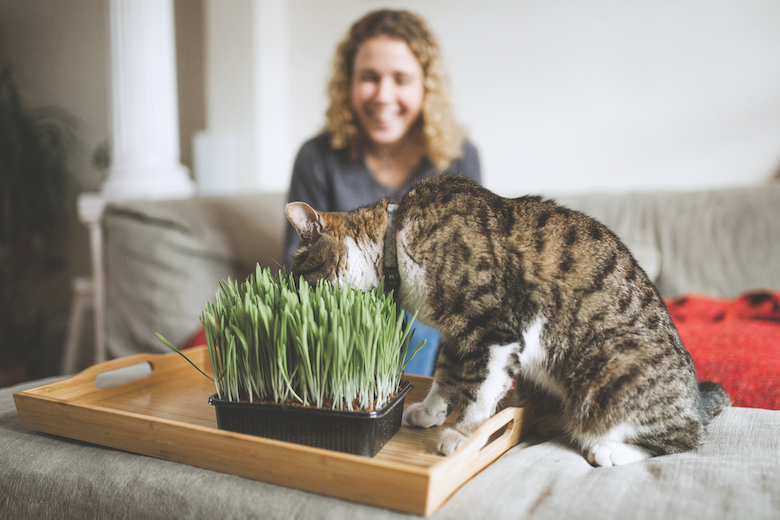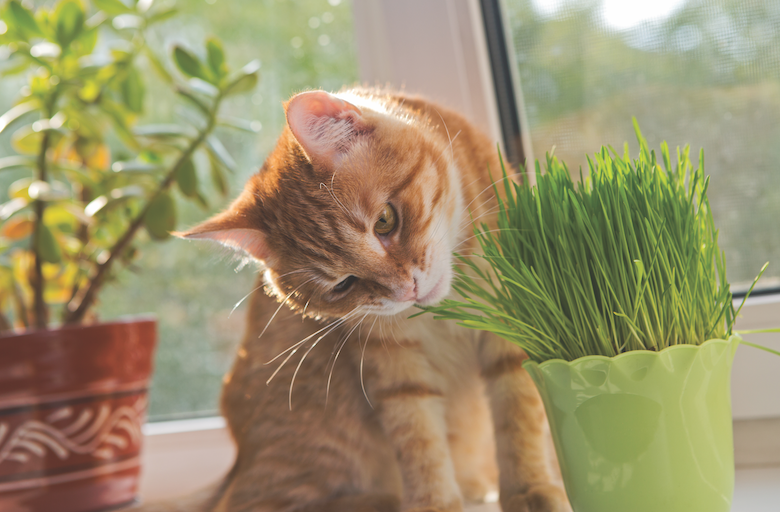If cats have been part of your family for a while, you know that they are obligate carnivores. That means their survival depends on having meat in their diets. So the first time you saw your little carnivore gnawing on grass or other vegetation may have shocked you as much as it did me the first time I witnessed it. So what is this obsession for some cats to eat grass? And why do some cats eat grass in the first place if they’re only going to vomit it right back up?
Are they sick?
Benjamin L. Hart, DVM, and a team of researchers from UC Davis School of Veterinary Medicine were also curious. In a 2008 study, they hypothesized that cats ate plants as a normal behavior they inherited from their wild ancestors to purge parasites. In fact, one of the sources Dr. Hart cited, “Food Habits of the Cougar in Utah and Nevada” published in The Journal of Wildlife Management in July 1959, documented the findings of plant material in cougar feces.
After surveying over 2,000 pet parents, Dr. Hart and his team found that cats do not appear ill before eating grass and that they do not regularly vomit afterward. Dr. Hart concluded that eating grass is not a sign of illness in cats, that it’s normal and that they inherited the trait from their wild ancestors.
Dr. Hart led another digital survey of over 1,000 cat parents in 2019,
and the results confirmed his earlier findings. He and his team observed that 71% of cats ate plants at least six times during their lives, 61% of cats ate vegetation at least 10 times and 11% of cats ate no plants. So not all cats eat plants, but the majority of them do. What surprised the researchers was that 91% of the time cats howed no sign of illness before eating plants.
They presented the results of this survey at the 2019 International Society for Applied Ethology conference in Bergen, Norway.
How much is too much?
Of the four cats I’ve cared for in my adult life, two of them ate grass and any other vegetation they could sink their teeth into. It’s why I’ve kept certain plants, especially lilies, out of my house. My other two cats never ate plants of any kind.
“Cats eat grass simply because they like the taste of it,” says Dr. Gary Norsworthy, a board-certified feline specialist at the Alamo Feline Health Center in San Antonio, Texas. “It is not due to the cat’s desire or need to purge. Some grasses are tastier than others, and the tasty ones are often only preferred when there is plenty of rainfall (or a good sprinkler system) because they are more lush and tasty.”

Photo: Linda Raymond | Getty Images
Best kitty grasses to buy and grow
Providing plenty of safe, nonpoisonous vegetation for indoor cats can keep them away from your other houseplants. The ASPCA’s guide to toxic and nontoxic plants is a comprehensive list to check before acquiring a plant for your home. For example, one plant that no cat home should have is any type of lily.
You can grow cat-safe grass indoors. This type of grass is not the same as lawn grass, which can contain harmful pesticides.
You can find 100% organic, non-GMO grass in pet stores, online and at a variety of retailers. You can also grow it yourself from seeds you purchase anywhere you find home and garden supplies.
Types of cat grass include:
- Alfalfa
- Oat
- Wheat
- Rye
- Barley
- Flax
Pet stores sell cat-grass kits that contain these various types of grass. From seeds, these grasses start to sprout in a few days and can be ready for your cat to chomp on in a couple weeks. The best grass depends on your cat’s preference.
Related: Why Do Cats Go Crazy for Catnip?
Here’s something to keep in mind, though. Most kinds of grass are not digestible for cats, Dr. Norsworthy cautions.
A little grass adds fiber to the cat’s diet, which can aid in digestion and reduce hairballs. The chlorophyll can even freshen a cat’s breath. But cats lack the enzyme needed to digest large quantities of grass, which leads to vomiting. Even worse, too much grass can be dangerous.
“A few years ago we went to surgery with a cat with an intestinal obstruction,” Dr. Norsworthy recalls. The obstruction turned out to be a wad of grass. Although the cat never went outside, his caretaker pulled a handful of grass on her way into the house at the end of each day. That proved to be too much grass for the cat.
As with treats, experts recommend cat grass should provide no more than 10% of a cat’s total caloric intake.
Featured image: Okssi68 | Getty Images
Read Next: Gardening With Cats: How to Create a Pet-Friendly Garden
